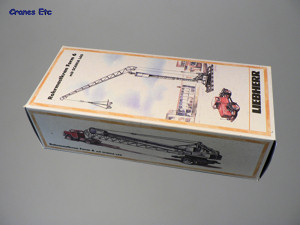 |
| NZG historic model
box. |
 |
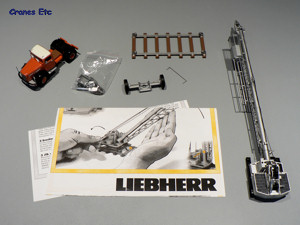 |
| The parts out of
the box. |
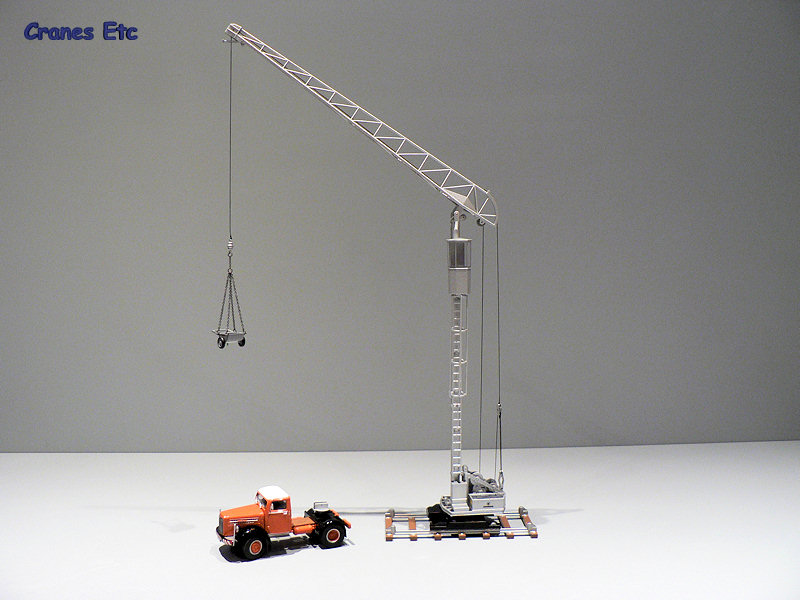 |
| The Liebherr
Form 6 and Scania L60. |
|
|
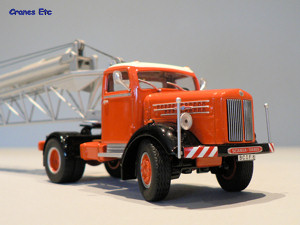 |
| The Scania tractor
unit is a good match for the crane. |
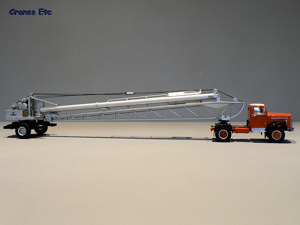 |
| If you do not have
space for the crane, you may have space for this pose.
|
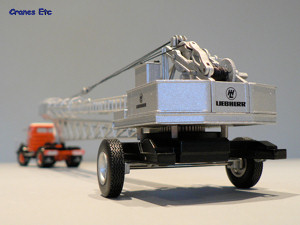 |
| Some kind of clip-on
light cluster or sign at the rear would have been good for
transport. |
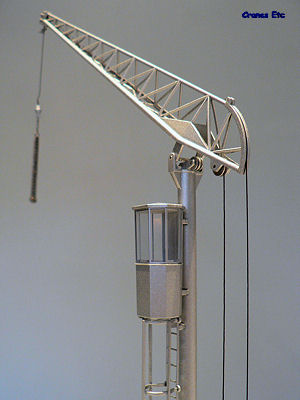 |
| Good, simple and
clean lines. |
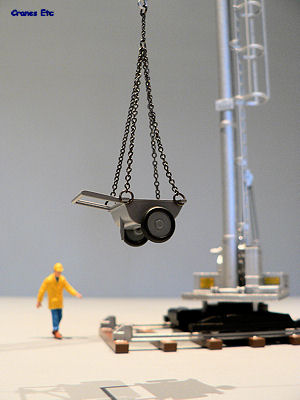 |
| A small wheelbarrow
provides a load and therefore tension for the hoist rope.
|
|
The Form 6 was one of the very early
cranes produced in 1953 by the Liebherr company and
represents the heritage from which it has since grown.
This is one of the series of historic models produced by
NZG. The set consists of the crane and a Scania L60
tractor unit. Both models are available separately.
Packaging
Unusually for a Liebherr model it is not packed in the typical
house style picture box. Instead it is contained in
one of NZG's historic series box with a drawing of the
model on the outer sleeve. Inside, the crane and truck
are contained in a pair of conventional expanded polystyrene
trays.
The review models were well packed and undamaged.
An instruction sheet is provided which has clear pictures,
but the text is all in German. A separate sheet has
English, French, Italian and Spanish translations.
The model is fully strung out of the box. Given the
historical significance of the real crane perhaps it is
a pity that information about it was not provided to compliment
the model.
Detail
The Scania L60 Tractor is a pleasing and well made vehicle.
The chassis has a detailed prop shaft and exhaust pipe and
the wheels have nice metal hubs and tyres. At the
front the bumper and wheel arches are metal and the lights
have small plastic lenses which give a quality feel and
this is continued by the windscreen wipers and wing mirrors.
The bodywork is cast very well with hinges and handles present.
Moving to the rear, the fuel tank, wheel arches and rear
bumper are metal. A plastic section representing a
wooden deck sits over the centre of the chassis.
A simple separate axle unit allows the crane to be transported,
towed by the Scania. For the crane a short section
of metal trackwork is provided and this has nicely rendered
wooden sleepers (ties) with the rail spikes detailed also.
The undercarriage of the Form 6 is a single cast piece and
has nicely modelled ballast blocks to simulate the counterweight
which provides stability for the crane. The ballast
block detail continues through into the crane itself where
the bulk of the counterweight is loaded. The casting
of the structure at the base is of fine quality with beam
sections having flange and web features.
The winch drums have toothed gear wheels representing the
original drive mechanism and the pinion for the hoist is
also modelled. Small warning notices complete the
detail.
The main structure is a metal tube which has a very good
plastic ladder and safety cage attached. These lead
to the cab which copies the spartan qualities of the original.
The plastic used in the windows is fine although it is a
solid piece horizontally just at the level of the bottom
of the windows and in some conditions it reflects and makes
the inside of the cab not seem quite right. Adding
to the detail there is also a small capacity board on the
front of the mast.
The jib is a pleasing piece which replicates the lattice
work of the original effectively. It is actually made
of two castings with the underside being a discrete section
attached to the top two sides. There are some nice
metal pulleys at the mast end of the jib. At the jib
tip there is a hoist cut-out bar.
The hook is nicely modelled and comes with a set of lifting
chains. Also provided is small metal barrow which
provides a load for the crane.
Features
The Scania L60 has working steering which works well although
cannot it produce a very hard lock without fouling the wheel
arches. The fifth wheel permits any suitable trailer
to be attached.
All the normal functions of the crane work. It moves
along the tracks and rotates easily. The two winches
can be operated by the supplied keys and they work smoothly
although the hoist winch really needs a load on the hook
to lower properly.
The crane can be posed in transport mode with the travelling
axle fixed. As an alternative pose the erection of
the crane can be simulated but only to a degree as the model
is not particularly stable except when the mast is close
to vertical.
Quality
The Scania L60 is a well made model with a very good paint
finish. The quality of the manufacture in the crane
is very good with all castings having good detail where
appropriate.
Paintwork and markings are also very
good and add to the impression that this is a high quality
model.
Price
The price of the set is reasonable.
Overall
For anyone interested in historic models of this type, this
set is a desirable pairing to own, and the quality of the
models means that there is no disappointment for the collector.
As a historic model some more information on the original
machines would have been a good addition. The set
offers a variety of poses either in transport or operating
modes.
Footnotes
The model first appeared at the Nuremberg Toy Fair in February
2007. This set comprises of two models. Each
model was also sold separately. Model 646 is the crane
only and the Scania L60 tractor unit is model 639. The
model was issued in revised packaging in 2024 to
commemorate the 75th anniversary of Liebherr. It
included a special poster.
|
|
|
|
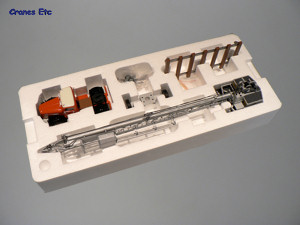 |
| The model is well
packed. |
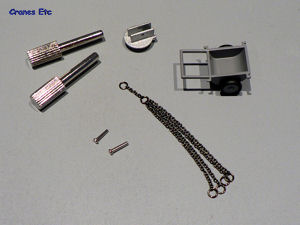 |
| Contents of the
bag. |
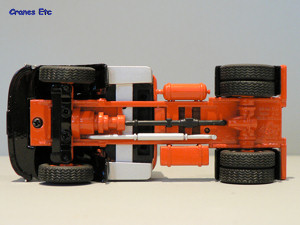 |
| Underneath, the
Scania is detailed. |
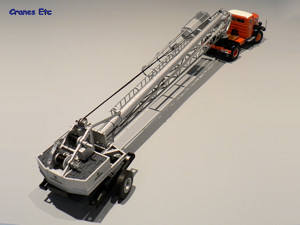 |
| The model looks
good in transport configuration. |
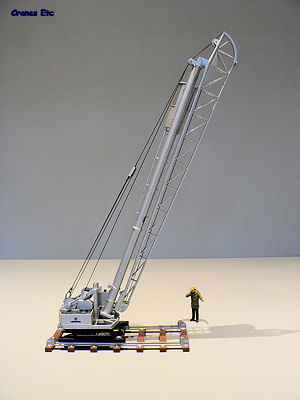 |
| The crane being
erected. As shown the crane is just at the tipping
point. |
|
|
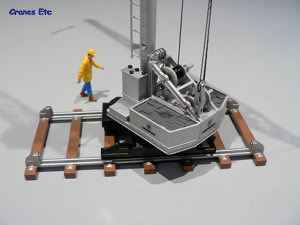 |
| Good detail with
the counterweight made to look like separate individual
blocks. |
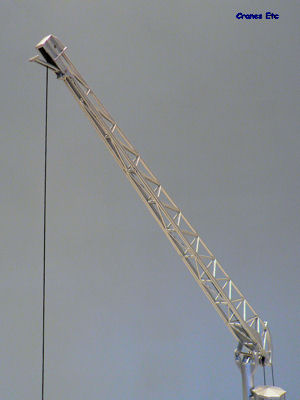 |
| The jib is fully
triangulated and is actually made of two lengthways pieces.
|
|

